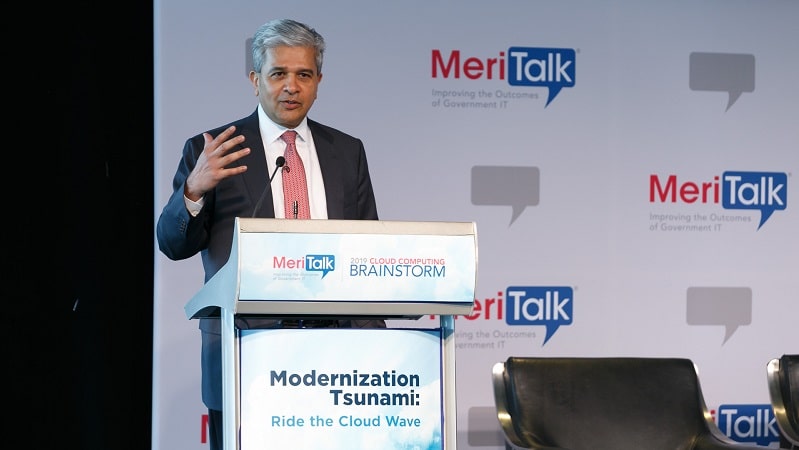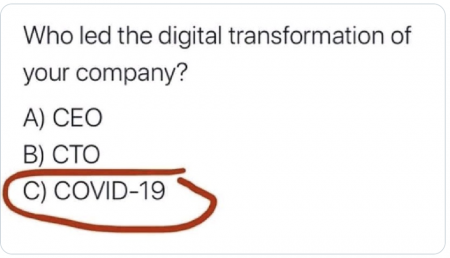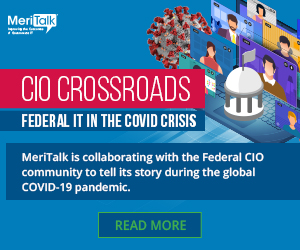
Often taken for granted in the eight weeks since the coronavirus pandemic struck is one simple but vital truth: the linchpin holding together the Federal government’s ability to provide crucial services is the technology that ties the enterprise together. Federal IT has literally brought us together – as a government, and as a nation. As government IT operations achieve steady-state and look to the next chapter of digital modernization, MeriTalk is chronicling the untold stories – and lessons – of that effort. Today we check in with the General Services Administration’s Technology Transformation Services (TTS) operation…
TTS Speeds Rapid Response to Agencies – CIO Q&A
If you asked a hundred people on the street what they knew about TTS, you’d be hard-pressed to get a good answer. But if you’re a Federal agency CIO with an eye on IT modernization, the reply might as likely be, “I have them on speed-dial.”
A comparatively small unit of just a few hundred souls, TTS in normal times signs on with agencies to spearhead modernization projects – think cloud, infrastructure, contact centers and so forth. But in these extraordinary times, TTS has been the go-to for pandemic response assistance that had to get done yesterday.
First, the story by the numbers. TTS has thrown in well over 10,000 work-hours – and up to 20 percent of its talent pool – to tackle rapid Federal agency pandemic response. One jewel in that crown is authentication technology to support the Small Business Administration’s (SBA) Paycheck Protection Program (PPP) which has facilitated more than a half trillion (yes, that’s trillion with a T) of funding to keep businesses afloat, with more than 110,000 log-ons.

Another is vital citizen service work with the Department of Health and Human Services (HHS) to set up telehealth.hhs.gov to provide resources to a highly-concerned public – and getting it done in a week. Add to that almost 1,000 FedRAMP reusability requests, work to meet spiking demand on USA.gov to the tune of 2.5 million website hits, and moving contact centers to telework amid a 75 percent increase in call volumes, and you start to get the idea.
So who are you going to call for IT help in a pandemic? It might just be this guy – Anil Cheriyan, Deputy Commissioner of GSA’s Federal Acquisition Service and Director of TTS. In an exclusive interview with MeriTalk, Cheriyan tells the story of how the organization tossed itself into the middle of the fight. And he offers the biggest lesson for government going forward – now is the time to move faster on digital transformation.
MeriTalk: Can you provide some metrics to illustrate the success of your work during the pandemic that ties to Federal agency missions?
Cheriyan: TTS has spent well over 10,000 work-hours on COVID-19 response. Between our 18F, Centers of Excellence, and Presidential Innovation Fellows organizations we are already tied up in work with numerous agencies, and so naturally we were asked to do a significant amount for agencies on pandemic response. Our platforms, like login.gov and cloud.gov, are in huge demand right now as agencies get more digital adoption.
And then with our FedRAMP systems, we’ve had around 1,000 requests in terms of reusability of FedRAMP that’s coming in from all of the different agencies. And lastly, we’ve got citizen-wide services – things like USA.gov, digital.gov, search.gov, and all of those have really spiked in terms of demand.
MeriTalk: Can you give us specific examples looking at cloud adoption, infrastructure optimization, contact centers, and customer experience?
Cheriyan: There are some examples we can’t talk about yet because we need agencies to give us the approval to do so, but let me tell you about ones we can talk about.
As soon as we started the COVID response, there’s been this huge amount of work that’s been done by every agency, like the Department of Health and Human Services (HHS). One of the big pushes that they’re working on is telehealth – how can you quickly tell whether you are suffering from symptoms, and do that all online before you go in and get tests.
So our team has been working closely with the HHS folks in building something called telehealth.hhs.gov. And the result is whatever you want to know about telehealth, it’s all out there. You can go online right now and look it up. That was done in about a week – which is a pretty short period of time to get something like that up and running.
Another big one, and probably the one we are most proud of, is the work we are doing with the Small Business Administration (SBA) and the agency’s CIO Maria Roat on the lender gateway for the Paycheck Protection Program (PPP) approved under the CARES Act. The PPP program hit with the first version, now we are on to the second version. They needed to get the site up and running, and our platform login.gov is really the core platform that does authentication there.
So we’ve had well over 110,000 people now logging in, using our login platform for SBA. We worked really closely with Maria and her team got that up and running, that was a tremendous amount of work. You captured most of it in your interview with Maria, but our teams were actively engaged with her in terms of getting that out. So in terms of digital adoption, better user experience, getting stimulus checks out there – that was a real fast-paced piece of work we got involved in.
MeriTalk: How many people are there at TTS, and how much of their recent efforts have been devoted to pandemic response?
Cheriyan: The 10,000 hours, just roughly speaking, is about 15 to 20 percent of our total hours. In total, we have about 280 in total – and 10,000 hours is probably our low end of the numbers. It doesn’t include contractors we are using, so it’s probably a lot higher than that.

MeriTalk: Enabling telework is obviously a first-priority work for you, what are some others you’ve been focused on? You talked about login.gov, are there any other areas?
Cheriyan: Others are Digital.gov and USA.gov, these are platforms that we’ve got out there to help citizens. We work closely with the Department of Homeland Security (DHS), there’s something called the Emergency Support Function – ESF-15. As soon as something like this hits, ESF-15 gets into place and USA.gov and Digital.gov are core components of responding by ESF- 15.
Just imagine this contact center – if you’re a citizen and you’ve got problems and you call about your safety first. We get so many calls from citizens who are worried about where are they getting their unemployment checks, what are they going to be doing, how are they going to respond, what do the CDC guidelines reflect. They call USA.gov first, and our spike in volumes and activities were rapid.
Not only that, but we had to move our contact center to be telework-focused rather than on-premises, so all of that had to be done on a pretty fast pace. That’s a really good example of how the team just jumped into it and really made the change. Digital.gov is the web version of that, so this provides guidance to all the agencies and that’s also closely tied in with the ESF-15 as well.
The USA.gov team is dedicated to continuing to provide the public with information, therefore ensuring communication is ongoing as the American public looks for answers is a priority of the team. The USA.gov contact center team worked to transition the staff to a work-at-home model, including over 45 information specialists who answer calls and respond to emails and chats from the public. This was done with no impact to the quality of the services offered.
MeriTalk: Any other metrics you can share about volumes that USA.gov has been seeing?
Cheriyan: In addition, USA.gov is amplifying key messages from partner agencies on social media and email, and handling an unprecedented number of calls and chats to its call center. To date, the web pages have been viewed more than 2.5 million times, and the call center has received more than 129,000 questions from the public, or about a 75 percent increase from the same period last year.
MeriTalk: From your perspective, what is the greatest IT lesson that the government has learned from this pandemic exercise?
Cheriyan: I’m sure you’ve seen the meme asking whether the top influencer of digital transformation is the CIO, the CEO, or COVID-19 … I think if there’s one lesson learned it’s now is the time if you are a CIO, let’s push for more telework, let’s push for all of those digital transformation initiatives. You talk about login.gov and cloud.gov and all of those things that we have – CIOs have the same issues in terms of how do you move their agencies to be more digital. Now’s the time to take that and push for it in terms of investments.
MeriTalk: We have the impression that TTS typically operates through a series of set engagements with agencies, but in the pandemic it sounds like you’re working with all kinds people. How does that process work – is it a call that goes out to agencies, and how do you sort through priorities?
Cheriyan: A lot of our projects are inter-agency agreements that we sign with agencies, and we keep them rolling. However, in this pandemic, based on our relationships with a lot of agencies and based on our existing contacts, we’ve been asked to do a lot of different things with the agencies.
It’s almost a natural process – you guys already are helping us here, here and here. SBA is a good example. They were aware of our login.gov capabilities, and we’ve been having those conversations with them. In fact we were going to launch that pilot on the lender gateway in the latter part of the year, and Maria basically said “Hey, we need it tomorrow, let’s go move on that.” So that’s an existing relationship for an existing pilot, and they just jumped on it and moved it forward.
And there’s been things like FedRAMP and USA.gov and digital.gov, these are cross-agency initiatives, and I think we’re just fortunate that we’re plugged in into a lot of those with the right responders from a code perspective.
We’re surprised that in some cases, even in this virtual world, we’re kicking off projects in a fully virtual way. There are going to be a couple of announcements that we’re going to make in the next week or so that are going to be exciting. It’s not COVID-related but they’ve been launched, they kicked off and we’ll be putting it out to the press. (Editors Note: subsequent to this interview TTS announced Centers of Excellence modernization engagements with the Food and Drug Administration and the National Institutes of Health.)
MeriTalk: Do you have any recommendations on inter-governmental collaboration during the pandemic and as we emerge from it?
Cheriyan: I think agency CIOs and the Office of Management and Budget (OMB) can continue to look at how to implement shared standards across agencies. We have multiple email systems and collaboration tools. Is now the time to start thinking about standardized fundamental infrastructure capabilities? Maybe, maybe not. It’s a huge undertaking to make that happen.
MeriTalk: Can you tell us a little bit about your days in the first week or so of the crisis? How have your days changed since then? Are you fully entrenched in the new normal? What does that look like now?
Cheriyan: It’s hard not being in the office, and trying to do everything from your couch instead. It became apparent very early on that we needed to have daily communication calls – within GSA, with other agencies, with [Federal CIO] Suzette Kent and OMB. All of this communication is a very positive thing – and not just from a business standpoint.
This is a difficult time for some people, especially those dealing with the very real ramifications of this virus, whether they have a loved one who is sick or they are spending their days alone at home. Communication is a big deal. We’ve started informal happy hours and other activities to make people feel engaged and connected.
MeriTalk: Any shout-outs you’d like to give any team members at TTS, GSA at large, or others across the government?
Cheriyan: Our team has done a tremendous job. There are many others I’d like to highlight for their amazing work in the future, but just to call out a few – our 18F team under Brian Whittaker, our CoE team with Bob De Luca, our Solutions team with Dominic Sale, Josh Di Frances for his leadership with the Presidential Innovation Fellowship (PIF) program, and Harry Lee who’s now head of Clients and Markets, working with the White House on a lot of these initiatives. We have a great team. I’m very fortunate to work with so many good people.
MeriTalk: A big picture question: what will change in our government and our society moving forward as a result of the pandemic – what will we do that is new, and what will we stop doing?
Cheriyan: I think digital shopping is one area. We’re in the right spot in the technology industry, though. Now is the time we can shine. Whether it’s AI or the Internet of Things, or tying everything together virtually, the tech industry is solving real challenges right now, and we will continue to step up to the plate.
MeriTalk: How will you and your team function in a world without conferences as we know them? How do you envision interacting with industry?
Cheriyan: This is an opportunity to rework the traditional conference style and format, where you have a main stage and breakout rooms. If you ask anyone what they get out of a conference, invariably they say networking and informal communications. How can we recreate those serendipitous interactions in a virtual setting? Nevertheless, we still need conferences. We still need those interactions with industry.
MeriTalk: Prior to MeriTalk, we formed a group called the Telework Exchange. We were very instrumental in the development of the 2012 Telework Enhancement Act, which significantly moved telework from an opt-in to an opt-out model. At that time, the GSA Office of Government-wide Policy was very involved in pan-government telework programs. Is that something you see continuing to go forward? What role will GSA play in telework after this?
Cheriyan: We are trying to figure that out as a team. As we figure out how and when to return to the building, the question becomes who do we need to have in the office and why? Right now, those discussions are primarily driven by the health and safety of our teammates. In the pre-COVID world, the number of people who “had to” be in the office was quite high. But now, things will change. If you’re a Public Building Service (PBS) building manager, you probably need to physically be there. But, if you’re a GSA contract specialist, you can do much of your work from home. It will be interesting to see how it shakes out as we continue to have these conversations government-wide.
Read more Federal success stories from the COVID-19 pandemic.
